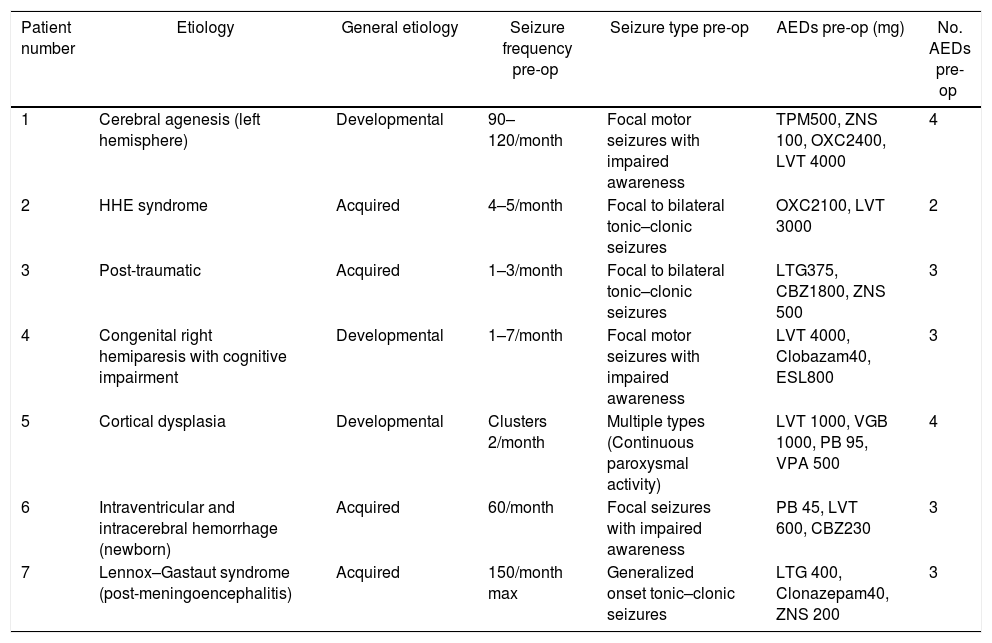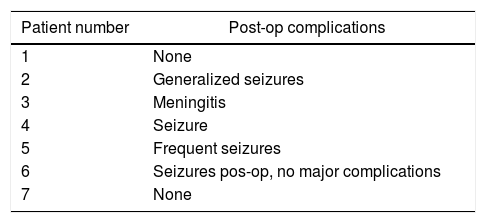Hemispherectomy has an established role as a treatment of last resort in patients with unilateral hemispheric lesions suffering from refractory epilepsy.
MethodsSeven patients were evaluated at our Epilepsy Unit. We compared the seizure outcome at 6 months, 1, 2, 5 years post-surgery, as well as at end follow-up (mean 7.1 years) using Engel classification. Reduction of antiepileptic drugs (AEDs) was also assessed utilizing equal time frames.
ResultsThe mean age of seizure onset was 5.4 years. Engel I was achieved in 5 patients at 6 months (71.4%). Engel at 1 year was predicted by the Engel at 6 months (p=0.013) with a similar number of patients being classified as Engel I outcome. Engel at 2 years was also predicted by Engel at 6 months and at 1 year (p=0.030). At end follow-up only 3 patients (42.9%) remained categorized as Engel I outcome. There was a trend toward a stability in Engel classification. All patients with developmental causes for their epilepsy experienced some deterioration of the surgical outcomes. Conversely, all patients with acquired causes were stable throughout follow-up. Seizure outcome at 6 months was worse in the patients who had post-op complications (p=0.044). Adult and pediatric populations did not differ significantly in any tested variable.
ConclusionsHemispherectomy is a valuable resource for seizure control in properly selected patients. Engel patient's evolution could be predicted at 6 months interval. Hemispherectomy could be considered a useful attitude in difficult cases.
La hemisferectomía tiene un rol establecido como último recurso de tratamiento en pacientes con lesiones hemisféricas unilaterales que padecen epilepsia refractaria.
MétodosEn nuestra Unidad de Epilepsia fueron evaluados 7 pacientes. Comparamos el resultado de la crisis epiléptica a los 6 meses, 1, 2 y 5 años posteriores a la cirugía, así como durante el seguimiento final (media 7,1 años) utilizando la clasificación de Engel. También se evaluó la reducción de fármacos antiepilépticos (FAE) utilizando marcos temporales iguales.
ResultadosLa edad media de aparición de la crisis fue de 5,4 años. Se logró Engel I en 5 pacientes a los 6 meses (71,4%). Engel a 1año fue predicho por Engel a 6 meses (p=0,013) con un número similar de pacientes clasificados como resultado Engel I. Engel a 2 años fue también predicho por Engel a 6 meses y 1año (p=0,030). Durante el seguimiento final solo 3 pacientes (42,9%) siguieron categorizados como resultado Engel I. Se produjo una tendencia hacia la estabilidad en la clasificación Engel. Todos los pacientes con causas evolutivas para la epilepsia experimentaron cierto deterioro de los resultados quirúrgicos. Por contra, todos los pacientes con causas adquiridas permanecieron estables a lo largo del seguimiento. El resultado de las crisis a los 6 meses fue peor en los pacientes con complicaciones posquirúrgicas (p=0,044). Las poblaciones adulta y pediátrica no difirieron significativamente en ninguna de las variables probadas.
ConclusionesLa hemisferectomía es un recurso válido para el control de la crisis en pacientes debidamente seleccionados. La evolución del paciente de Engel pudo predecirse a intervalos de 6 meses. La hemisferectomía podría considerarse una actitud útil en casos difíciles.
Article

If it is the first time you have accessed you can obtain your credentials by contacting Elsevier Spain in suscripciones@elsevier.com or by calling our Customer Service at902 88 87 40 if you are calling from Spain or at +34 932 418 800 (from 9 to 18h., GMT + 1) if you are calling outside of Spain.
If you already have your login data, please click here .
If you have forgotten your password you can you can recover it by clicking here and selecting the option ¿I have forgotten my password¿.













